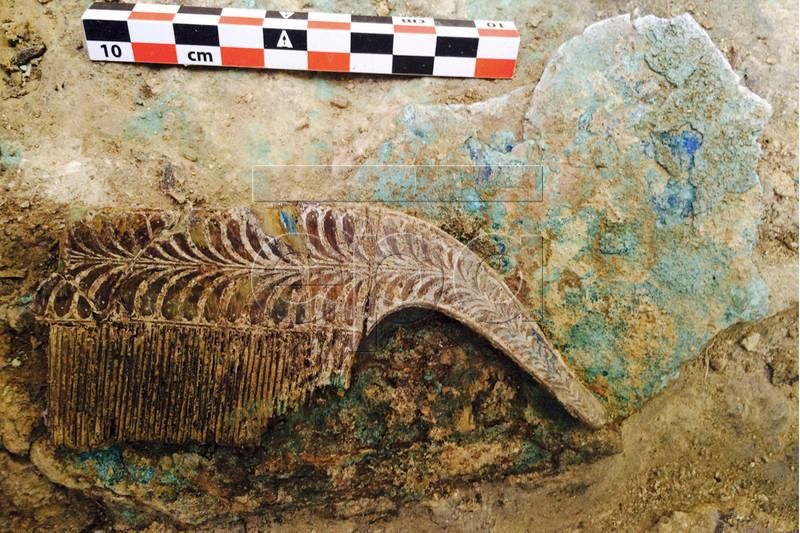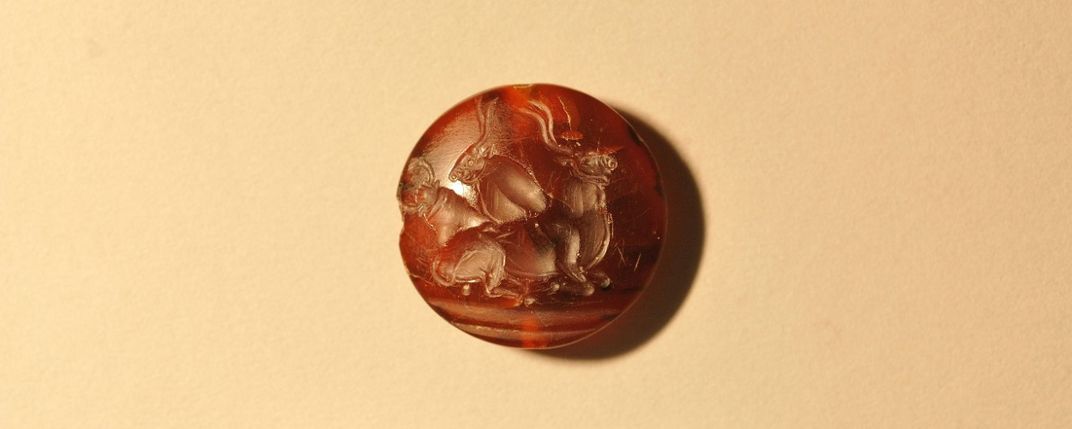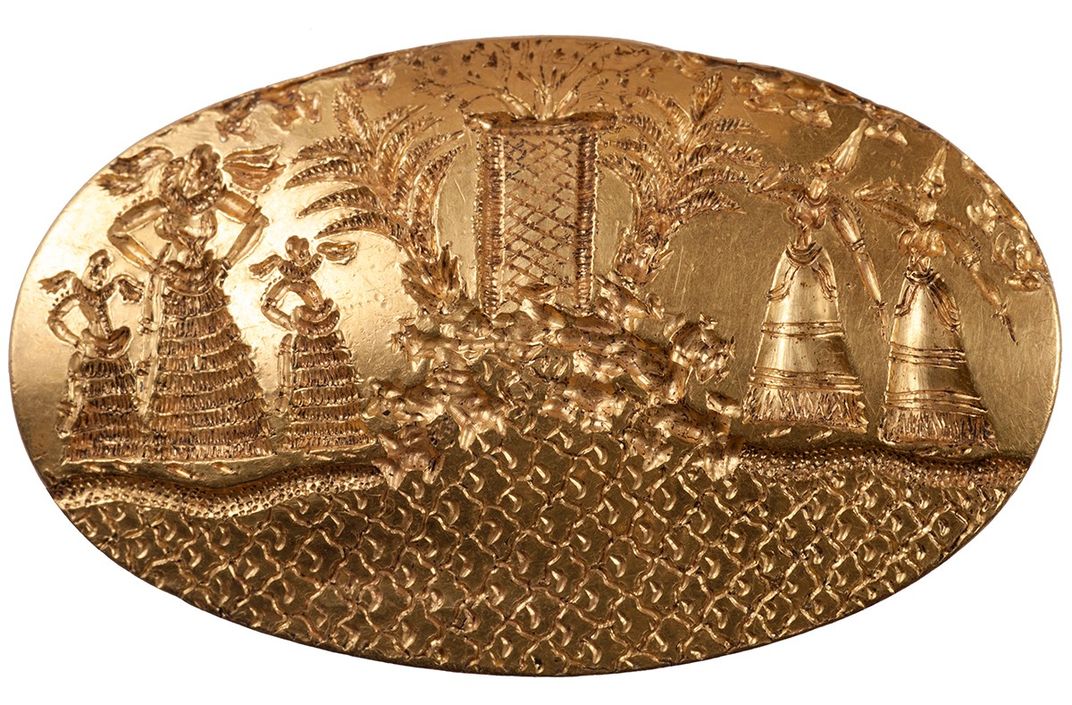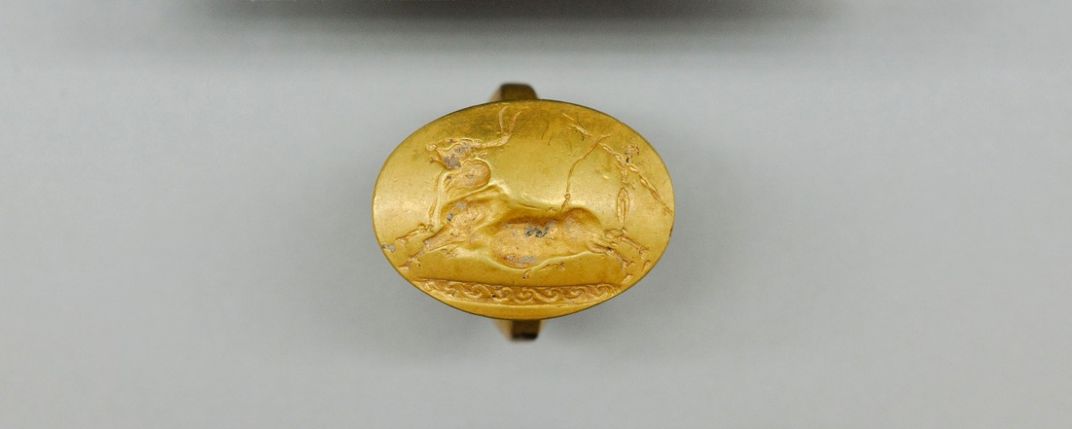Gold Rings Found in Warrior’s Tomb Connect Two Ancient Greek Cultures
Analysis of four gold rings and some 2,000 other recently uncovered objects points to the exchange of ideas and goods between two ancient peoples
The Minoan Civilization flourished on the Island of Crete from around 2600 B.C. to 1200 B.C., building the foundation for classical Greek culture. The ancient Greece of ancient Greece, if you will, the people developed religious concepts, art and architecture that would go on to influence the whole of Western civilization. But their reign was believed to fall when the Mycenaean civilization, which developed on the Peloponnese Peninsula (and gave rise to the heroes of The Iliad), plundered the Minoans and absorbed some aspects of their civilization into their own culture.
But the grave of a Mycenaean warrior uncovered last year in Pylos in the southwest of Greece may tell a different tale, reports Nicholas Wade at The New York Times. In May 2015, archaeologists Shari Stocker and Jack Davis from the University of Cincinnati uncovered the pristine warrior’s grave near the Palace of Nestor in Pylos. The body was that of a warrior in his mid-30s who died around 1500 B.C., Rachel Richardson writes for UC Magazine. Buried with him were some 2,000 objects, including silver cups, beads made of precious stones, ivory combs, a sword and four intricately decorated solid gold rings.
The discovery of the man, dubbed the “Griffin Warrior” because of an ivory plaque decorated with the mythical beast found with him, offers evidence that Mycenaean culture recognized and appreciated Minoan culture more than previously believed, researchers outline in an article soon to be published in the journal Hesperia.
Of particular interest are the man's rings. They are made of multiple sheets of gold and depict very detailed scenes and iconography straight out of Minoan mythology. The rings probably come from Crete where they were used to place seals on documents or objects. The bull, a sacred symbol for Minoans, appears in two of the rings and the Griffin Warrior was buried with a bronze bull’s head staff.
After a year of examining the treasures, Stocker and Davis believe the Mycenaeans, or at least the ones who buried the Griffin warrior, weren’t just pillaging the Minoans for their pretty jewelry. They were exchanging ideas and directly adopting aspects of Minoan culture. They also argue that the Minoan goods and iconograpy were treated like symbols of political power.
“People have suggested that the findings in the grave are treasure, like Blackbeard’s treasure, that was just buried along with the dead as impressive contraband,” Davis tells Richardson. “We think that already in this period the people on the mainland already understood much of the religious iconography on these rings, and they were already buying into religious concepts on the island of Crete.”
He believes the society that buried the Griffin Warrior was knee-deep in Minoan culture. “Whoever they are, they are the people introducing Minoan ways to the mainland and forging Mycenaean culture. They were probably dressing like Minoans and building their houses according to styles used on Crete, using Minoan building techniques,” he says.
Cynthia W. Shelmerdine of the University of Texas, an expert on the Bronze Age in the Aegean, tells Wade that she agrees that the Minoan rings and other objects found in the grave represent political power in the Griffin Warrior’s culture. “These things clearly have a power connection…[and] fits with other evidence that the elites on the mainland are increasingly closely connected to the elites on Crete whether or not the rings were used in the Minoan way for sealing objects.”
Wade says while the Mycenaean culture adapted many aspects of the Minoans, their direct connection to and memory of that society faded over time and mainly survived in some of the myths they collected from Crete.
The researchers will publicly debut the rings and other objects from the excavation during a lecture this upcoming Thursday.





